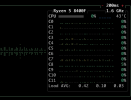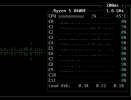hello,
so I set up NAS: RAIDz2 of 8 x WD hc530 with special vdev (Samsung PM963), Ryzen 8400f, 32 GB
playing with compression types
I clearly see reasonable cpu load with compressions during write. But I don't see it for reading (while speed is much lower). You might say disks are limiting speed, but almost or no compression gives decent read speed.
No (or almost) compression gives 250-350 MB/s, zstd compression - 100 MB/s. But zstd with recordsize=16M gives 260 MB/s
If disks are able to deliver 300 MB/s, why can't they with compression which should only depend on cpu (and helps disks as there's less data to deal) ??? curiosity kills me
I do testing by copying 200 photos in raw format (10.2 GB) from zfs to ramdisk
* files (photos) are different, thus photo set for each case slightly varies in size (and compressibility)
edit: added column with compressed folder size
so I set up NAS: RAIDz2 of 8 x WD hc530 with special vdev (Samsung PM963), Ryzen 8400f, 32 GB
ashift=12, recordsize=4M, others are quite defaultplaying with compression types
I clearly see reasonable cpu load with compressions during write. But I don't see it for reading (while speed is much lower). You might say disks are limiting speed, but almost or no compression gives decent read speed.
No (or almost) compression gives 250-350 MB/s, zstd compression - 100 MB/s. But zstd with recordsize=16M gives 260 MB/s
If disks are able to deliver 300 MB/s, why can't they with compression which should only depend on cpu (and helps disks as there's less data to deal) ??? curiosity kills me
I do testing by copying 200 photos in raw format (10.2 GB) from zfs to ramdisk
| compression | recordsize, MB | time, s | speed, MB/s | compressed, GB* |
|---|---|---|---|---|
| off | 4 | 29 | 360 | 10.2 |
| zle | 4 | 41 | 254 | 9.8 |
| lz4 | 4 | 43 | 242 | 9.7 |
| lz4 | 16 | 22 | 474 | 9.7 |
| zstd | 4 | 89 | 117 | 7.8 |
| zstd | 8 | 53 | 197 | 8.1 |
| zstd | 16 | 39 | 267 | 7.9 |
| gzip | 4 | 91 | 115 | 7.2 |
* files (photos) are different, thus photo set for each case slightly varies in size (and compressibility)
edit: added column with compressed folder size


